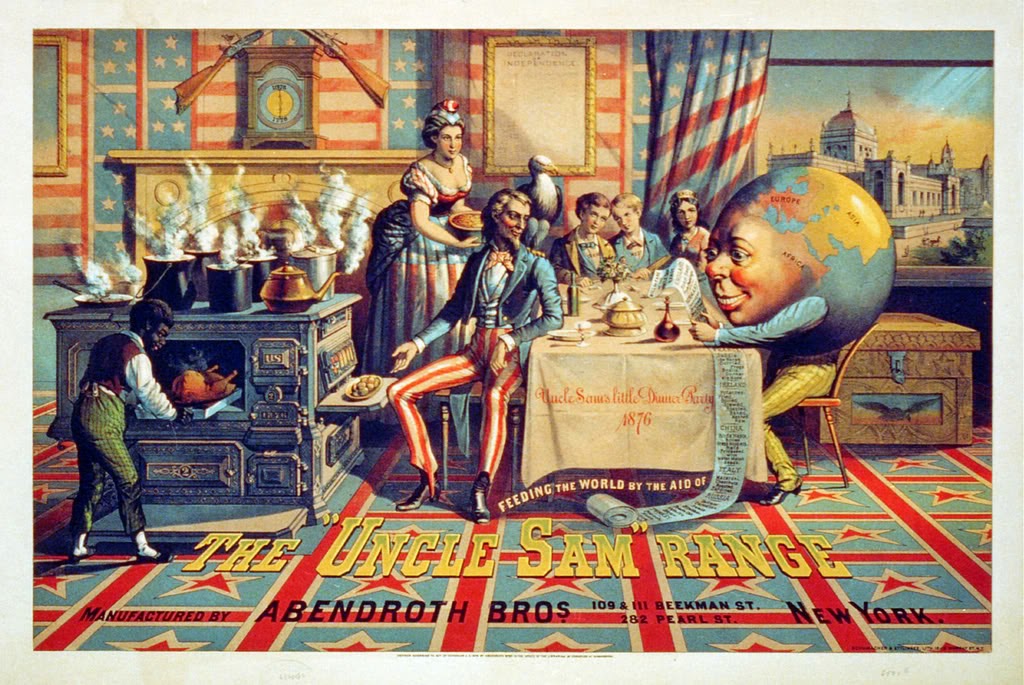With
a modern eye ‘The Uncle Sam Range’
advertisement -created in 1876 by Schumacher & Ettlinger - can seem
complicated at first. It seems unusual for the product being advertised (in
this case an oven) not to be centre of attention. However, the outstanding
political message is hard to miss.
The
company’s American routes are made obvious by a number of visual ‘clues’.
Firstly, the red, white and blue colours seem to absorb all objects around
them. Not to mention the stars and
stripes swallowing up the carpet, curtain and walls. All this is representative
of the American flag. Other symbols representative of America are used such as
eagles and guns. On closer analysis, the clock shows dates (1776 and 1876).This
acknowledges and celebrates the 100 years of America’s independence. The font
on the dinner table seems extravagant like this potential American lifestyle
shown. Furthermore, the classic uppercase western font displayed at the bottom
of the image in shining gold, reflects America’s power, wealth and authority.
The painting style of the advert also reflects a regal feeling. There is a
clear sense of patriotism and pride in America that cannot be missed.
So,
why is the advert more focussed on America than the product itself? Judging
from the imagery used, the idea is that the world has come to “Uncle Sam’s Little
Dinner Party 1876”. This sounds positive at first, but if you look closely at
the receipt held by ‘the world’, the racism and mockery towards other countries
comes to light. Also, the use of the slave shows America’s attitude to the rest
of the world- despite the abolishment of slavery in 1833. America appears to be
boasting of its cultural superiority whilst belittling other countries. The
advert is suggesting that if you buy this cooker, you will be living the
American dream, as illustrated in the image itself.
The
viewer imagines this American dream. No matter who you are or what background
you have come from, you will succeed and be prosperous in America. The target
audience is questionable. It could be aimed at the middle class, illustrating to
them the extravagant lifestyle that they could lead if they were to purchase the
oven. If aimed at the upper class, it simply competes with the other cookers on
the market and comforts them that their ideal lifestyle will be possible with
the product. It is likely that the image is aimed at men, as a man is the
centre of the image and all is revolving around him. This was the culture of
the time.
In
1915, a poster with many similarities to Uncle Sam’s, was produced by Savile
Lumley. The poster is far more
simplistic. The illustration is set in the future and it shows a father and two
children in what appears to be the sitting room. The advert communicates that
the daughter is asking her father the question written at the bottom of the
poster - “Daddy, what did YOU do in the Great War?”. The poster aims to
make the viewer feel a sense of guilt and therefore guilt trip men into
becoming soldiers.
The question can be answered in two ways,
however, the stern look on the fathers face suggests that he did not put
himself forward as a solider. This forces the viewer to imagine the potential
consequences and embarrassment if did not become a solider. The imagery also
promotes being protective towards your family- if you don’t go to war, you are
not protecting your family!
The
use of a script font for the caption expresses the innocence of the child and
makes the advert feel more personal. The ‘YOU’ is capitalised and
underlined- this combined with the father looking directly towards the viewer
makes the advert very direct and almost commanding. The son in the image
clearly looks up to the army as he plays with his war toys. The viewer can
imagine the boy explaining how he would join the army, so why didn’t you daddy?
All of these tools only increase the pressure to become a solider.
There
is an interesting use of colour in the advert. Both males are dressed in warm
colours , yet the girl who is asking the question is dressed in colder blue
colours. This may represent the coldness women would feel towards men if they
were too cowardly to join the army.
The
image shares the same patriotism as Uncle Ben’s. The curtains are layered in
red roses, a symbol of England. Likewise, another symbol of England – a fleur
de lis – covers the chair. In both images there is a shared sense of pride, in
yourself or in your country. There is a
common aim to persuade the audience in terms of sale. Uncle Ben’s aims to sell
the product, whereas you are guilt tripped into selling your life for the
second image. There is also an offer of contentment or promise that is
visualised in the image, the viewer naturally wants to aim for this. Finally,
both images appear to be aimed at men. The male is always central and this
reflects the time period and culture when these images were produced. In modern
day, it could be argued that more pressure is on women, but in these images it
is clear that in the past, an immense amount of pressure was laid on men.


No comments:
Post a Comment